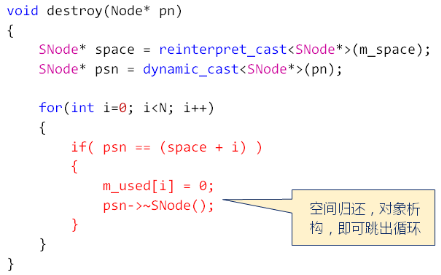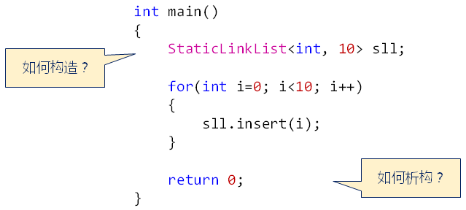数据结构开发(7):典型问题分析(Bugfix)
0.目录
1.创建异常对象时的空指针问题
2.LinkList 中的数据元素删除
3.LinkList 中遍历操作与删除操作的混合使用
4.StaticLinkList 中数据元素删除时的效率问题
5.StaticLinkList 是否需要提供析构函数?
6.StLib 是否有必要增加多维数组类?
1.创建异常对象时的空指针问题
ISSUE 1——创建异常对象时的空指针问题:

改进Exception.cpp:
在init函数中改进strdup的赋值方法
void Exception::init(const char* message, const char* file, int line)
{
/* message指向的字符串有可能在栈上,有可能在堆空间,还有可能在全局数据区
* strdup()将字符串复制一份到堆空间中
* file:发生异常的文件名
* line:发生异常的行号
* m_location的长度加2,一个给":",一个给"\0"
*/
m_message = (message ? strdup(message) : NULL);
if( file != NULL )
{
char sl[16] = {0};
itoa(line, sl, 10);
m_location = static_cast<char*>(malloc(strlen(file) + strlen(sl) + 2));
if( m_location != NULL )
{
m_location = strcpy(m_location, file);
m_location = strcat(m_location, ":");
m_location = strcat(m_location, sl);
}
}
else
{
m_location = NULL;
}
}
2.LinkList 中的数据元素删除
ISSUE 2——LinkList 中的数据元素删除:

单链表的实现没有考虑异常安全性!
改进LinkList.h中的remove函数和clear函数:
bool remove(int i)
{
bool ret = ((0 <= i) && (i < m_length));
if( ret )
{
Node* current = position(i);
Node* toDel = current->next;
current->next = toDel->next;
m_length--;
destroy(toDel);
}
return ret;
}
void clear()
{
while ( m_header.next )
{
Node* toDel = m_header.next;
m_header.next = toDel->next;
m_length--;
destroy(toDel);
}
}
3.LinkList 中遍历操作与删除操作的混合使用
ISSUE 3——LinkList 中遍历操作与删除操作的混合使用:

混合使用导致了m_current指向了已经被删除的结点,于是程序出错。
改进LinkList.h中的remove函数:
bool remove(int i)
{
bool ret = ((0 <= i) && (i < m_length));
if( ret )
{
Node* current = position(i);
Node* toDel = current->next;
if( m_current == toDel )
{
m_current = toDel->next;
}
current->next = toDel->next;
m_length--;
destroy(toDel);
}
return ret;
}
main.cpp测试
#include <iostream>
#include "LinkList.h"
using namespace std;
using namespace StLib;
int main()
{
LinkList<int> list;
for(int i=0; i<5; i++)
{
list.insert(i);
}
for(list.move(0); !list.end(); list.next())
{
if( list.current() == 3 )
{
list.remove(list.find(list.current()));
cout << list.current() << endl;
}
}
for(int i=0; i<list.length(); i++)
{
cout << list.get(i) << endl;
}
return 0;
}
运行结果为:
4
0
1
2
4
4.StaticLinkList 中数据元素删除时的效率问题
ISSUE 4——StaticLinkList 中数据元素删除时的效率问题:

改进LinkList.h中的destroy函数:
void destroy(Node* pn)
{
SNode* space = reinterpret_cast<SNode*>(m_space);
SNode* psn = dynamic_cast<SNode*>(pn);
for(int i=0; i<N; i++)
{
if( psn == (space + i) )
{
m_used[i] = 0;
psn->~SNode();
break;
}
}
}
main.cpp测试
#include <iostream>
#include "StaticLinkList.h"
using namespace std;
using namespace StLib;
int main()
{
StaticLinkList<int, 10> list;
for(int i=0; i<5; i++)
{
list.insert(i);
}
list.remove(3);
for(int i=0; i<list.length(); i++)
{
cout << list.get(i) << endl;
}
return 0;
}
运行结果为:
0
1
2
4
5.StaticLinkList 是否需要提供析构函数?
ISSUE 5——StaticLinkList 是否需要提供析构函数?:

构造函数与析构函数不会发生多态,于是调用的是父类的析构函数!
改进StaticLinkList.h:
在子类StaticLinkList中实现析构函数:
~StaticLinkList()
{
this->clear();
}
6.StLib 是否有必要增加多维数组类?
ISSUE 6——StLib 是否有必要增加多维数组类?:
多维数组的本质:数组的数组!
不需要定义多维数组!
使用DynamicArray创建多维数组:
#include <iostream>
#include "DynamicArray.h"
using namespace std;
using namespace StLib;
int main()
{
DynamicArray< DynamicArray<int> > d;
d.resize(3);
for(int i=0; i<d.length(); i++)
{
d[i].resize(i + 1);
}
for(int i=0; i<d.length(); i++)
{
for(int j=0; j<d[i].length(); j++)
{
d[i][j] = i * j;
}
}
for(int i=0; i<d.length(); i++)
{
for(int j=0; j<d[i].length(); j++)
{
cout << d[i][j] << " ";
}
cout << endl;
}
return 0;
}
运行结果为:
0
0 1
0 2 4
实践经验:
- 是软件就有bug,因此需要不停的迭代升级,解决问题。库是一种特殊的软件产品,也会存在各种bug,也需要迭代升级,解决问题。


【推荐】还在用 ECharts 开发大屏?试试这款永久免费的开源 BI 工具!
【推荐】国内首个AI IDE,深度理解中文开发场景,立即下载体验Trae
【推荐】编程新体验,更懂你的AI,立即体验豆包MarsCode编程助手
【推荐】轻量又高性能的 SSH 工具 IShell:AI 加持,快人一步